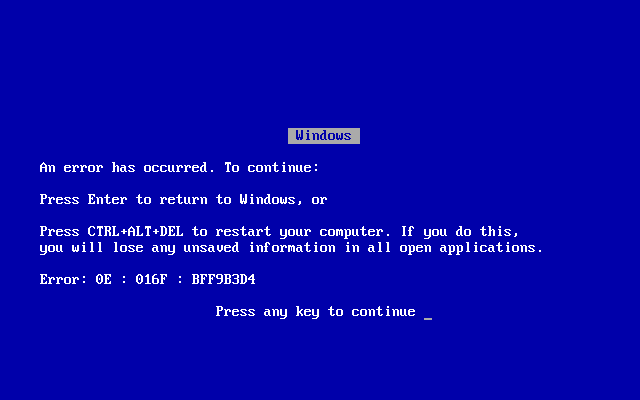The History of the Three-Finger Salute
CTRL+ALT+DEL, also known as Control Alt Delete, is a familiar combination for anyone who used a Microsoft Windows-based computer in the 1990s. When things went wrong — the computer froze up or the dreaded “Blue Screen of Death,” above, appeared — simultaneously striking these three keys on one’s keyboard was often the best route to recovery. (Pulling the power cord out of the wall was probably more effective but a little drastic.) CTRL+ALT+DEL become such a common habit of personal computer users (back when the machines were still called “personal computers”) that the ritual became known as the “three-finger salute” and performing it became normal.
Except: it probably should have never been known about in the first place.
The combination dates back to the late-1970s. IBM was developing one of the first personal computers, and the lead engineer of the PC project, a man named David Bradley, realized that testing the computer required that it be rebooted often. Typically, that required powering the computer down and restarting it, which slowed everything down. So, per Wikipedia, he coded up the machines so that CTRL+ALT+ESC would toss the PC into a “soft reboot” — a restart without having to power down. But his choice of keys proved dangerous, as all three keys sat on the left of the keyboard, and therefore could be accidentally mashed in unison. That’s bad. So a colleague suggested swapping out the ESC key for the DEL key, positioned across the keyboard and therefore requiring a hopefully-purposeful two-handed action. Bradley switched the keys. From that point on, the IBM PC had a hidden way to reboot itself on command, as he and his team needed.
Problem solved, the development team moved onto other tasks. (Bradley himself would later claim that building this feature took maybe five or ten minutes, and that it was at best an afterthought as part of a much larger project.) CTRL+ALT+DEL became one of many behind-the-scenes tools, but not one which anyone thought of as particularly interesting our groundbreaking. If anything, the three-key reboot process was seen as an inelegant solution, but no one really cared — it was intended only for internal IBM developers who really needed such a tool.
But the key combination would prove useful to others, and the odds of accidentally setting it off were low, so IBM didn’t simply let it remain as an internal tool. The original customers for IBM PCs were high tech, hands-on group — one that needed to reboot often as well. IBM decided to include Bradley’s five minute work-around in the documentation for the early machines. Anyone who actually read the manual learned that by simultaneously striking the CTRL, ALT, and DEL keys, the computer would restart. Many of these customers pored over the docs, needing to learn how to use their new toy, but for the general public, that wasn’t all that interesting. As the 1980s gave way the the 1990s, the “feature” rarely saw the light of day.
And then came Windows.
The Windows operating system was Microsoft’s foray into a Mac-like graphical user interface for IBM machines, but it may be better known for crashing a lot. Users needed to reboot rather often and powering the machine off and restarting it took a lot of time. The old IBM developers knew the trick and started sharing it with others, and, according to Mental Floss, “a quick fix spread from friend to friend” — CTRL+ALT+DEL. With a few keystrokes, you could restart your computer right away (assuming the keyboard was still responding).
Ultimately, Microsoft decided to adopt the three-finger salute as a suggested solution for the Blue Screen of Death, including it as one of the options suggested by the crash screen. And from there, it entered the computer-user lexicon.
 Bonus Fact: In the books and movies “The Hunger Games,” there’s an actual three-finger salute, seen here, which as the New York Times notes, “begins [in the story line] as a gesture of gratitude and farewell and evolves into a symbol of defiance.” But why was the New York Times reporting on the Hunger Games salute in the first place? Because in November of 2014, students in Thailand were using the salute to signify their dissatisfaction with the military-led government which had taken control of the country via a coup in May of that year. The saluting students were arrested and detained for a day as a result. As CNN reported, the junta banned “political activities” shortly after taking power, and saw the salute — a protest — as one such activity.
Bonus Fact: In the books and movies “The Hunger Games,” there’s an actual three-finger salute, seen here, which as the New York Times notes, “begins [in the story line] as a gesture of gratitude and farewell and evolves into a symbol of defiance.” But why was the New York Times reporting on the Hunger Games salute in the first place? Because in November of 2014, students in Thailand were using the salute to signify their dissatisfaction with the military-led government which had taken control of the country via a coup in May of that year. The saluting students were arrested and detained for a day as a result. As CNN reported, the junta banned “political activities” shortly after taking power, and saw the salute — a protest — as one such activity.
From the Archives: Card Clickers: The surprising history of Microsoft Windows’ greatest achievement: that really addictive Solitaire game.
Take the Quiz: Can you name the original tabs from the Windows 95 Start Menu? I only got four right, but that’s because I almost never turn my computer off the right way.
Related: CTRL+ALT+DEL coffee cups, for when you need a reboot, too.

